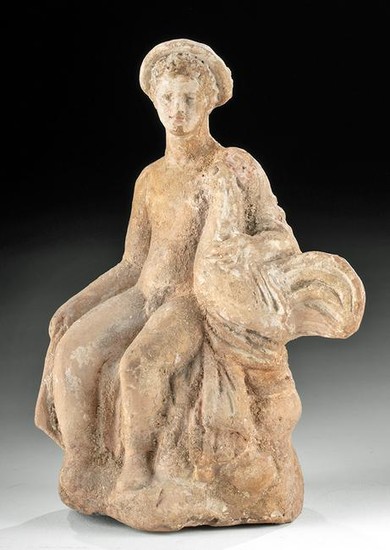Greek Hellenistic Pottery Seated Boy w/ Rooster
Greece, Hellenistic period, ca. 3rd century BCE. A charming, mold-made terracotta figure of a young man, nude aside from a rounded cap and a himation over one shoulder, seated and holding a large rooster under one arm. There are traces of white pigment on the man's face, and red pigment on the rooster's crest; a pink or orange pigment is in the lower profile areas of the himation. Size: 4" W x 6.1" H (10.2 cm x 15.5 cm)
The rooster may represent a beloved pet or a potential sacrifice. Roosters were a popular pet for young boys in Greece, as exemplified by a similar sculpture in the Metropolitan Museum of Art (06.1087). Animal gifts - especially roosters - also seem to have been common gifts from older men to younger ones. However, in the Hellenistic period, Greeks also had extensive cultural contact with the Egyptians, and in Egyptian cults roosters were a common sacrifice in rituals relating to the underworld and afterlife. Burnt chicken bones have been found at several Greek sanctuaries dedicated to the goddess Isis.
Provenance: ex-William Froelich collection, New York, New York, USA, acquired in the 1970s
All items legal to buy/sell under U.S. Statute covering cultural patrimony Code 2600, CHAPTER 14, and are guaranteed to be as described or your money back.
A Certificate of Authenticity will accompany all winning bids.
We ship worldwide to most countries and handle all shipping in-house for your convenience.
#149876
Condition Report: Expertly repaired and restored with overpainting along the repair lines; this is mainly evident on the back and legs. Nice remaining detail and some pigment.
View it on
Sale price
Estimate
Time, Location
Auction House
Greece, Hellenistic period, ca. 3rd century BCE. A charming, mold-made terracotta figure of a young man, nude aside from a rounded cap and a himation over one shoulder, seated and holding a large rooster under one arm. There are traces of white pigment on the man's face, and red pigment on the rooster's crest; a pink or orange pigment is in the lower profile areas of the himation. Size: 4" W x 6.1" H (10.2 cm x 15.5 cm)
The rooster may represent a beloved pet or a potential sacrifice. Roosters were a popular pet for young boys in Greece, as exemplified by a similar sculpture in the Metropolitan Museum of Art (06.1087). Animal gifts - especially roosters - also seem to have been common gifts from older men to younger ones. However, in the Hellenistic period, Greeks also had extensive cultural contact with the Egyptians, and in Egyptian cults roosters were a common sacrifice in rituals relating to the underworld and afterlife. Burnt chicken bones have been found at several Greek sanctuaries dedicated to the goddess Isis.
Provenance: ex-William Froelich collection, New York, New York, USA, acquired in the 1970s
All items legal to buy/sell under U.S. Statute covering cultural patrimony Code 2600, CHAPTER 14, and are guaranteed to be as described or your money back.
A Certificate of Authenticity will accompany all winning bids.
We ship worldwide to most countries and handle all shipping in-house for your convenience.
#149876
Condition Report: Expertly repaired and restored with overpainting along the repair lines; this is mainly evident on the back and legs. Nice remaining detail and some pigment.



